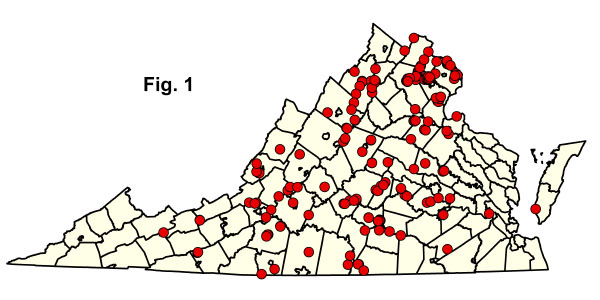
 Sở Bảo Tồn và Giải Trí
Sở Bảo Tồn và Giải Trí Bảo Tồn. Bảo Vệ. Tận Hưởng.
 Sở Bảo Tồn và Giải Trí
Sở Bảo Tồn và Giải Trí  Mục lục
Mục lụcCây sồi axit - Rừng Hickory
Forests in this group are similar to those of the Basic Oak-Hickory Forests, but occupy submesic to subxeric upland sites with soils weathered from subacidic parent material such as siltstone, metasiltstone, shale, certain granites, and various metamorphic rocks. These forests are widely distributed throughout the Piedmont, mountain valleys, and lower mountain slopes of both the Blue Ridge and Ridge and Valley, up to about 600 m (2,000 ft) elevation. They were probably once also frequent in better soils of the Coastal Plain, but now only widely scattered remnants remain there. Hickories (Carya spp.) are less abundant than in the Basic Oak-Hickory Forests group but are nevertheless common, often primarily as understory trees. Dominant oaks include white oak (Quercus alba), black oak (Quercus velutina), scarlet oak (Quercus coccinea), northern red oak (Quercus rubra), southern red oak (Quercus falcata), and chestnut oak (Quercus montana). Flowering dogwood (Cornus florida) is a characteristic, often abundant understory tree, although its numbers have been greatly reduced in recent decades by the fungal pathogen dogwood anthracnose (Discula destructiva). Deciduous ericads, especially lowbush blueberry (Vaccinium pallidum) and deerberry (Vaccinium stamineum), are usually present but patchy in the shrub layer, along with maple-leaved viburnum (Viburnum acerifolium). Herbaceous diversity is somewhat less than in Basic Oak-Hickory Forests but considerably greater than in Oak/Heath Forests. Typical herbs of these communities include plaintain-leaved pussytoes (Antennaria plantaginifolia), Pennsylvania sedge (Carex pensylvanica), whorled coreopsis (Coreopsis verticillata), poverty oatgrass (Danthonia spicata), common dittany (Cunila origanoides), rattlesnake weed (Hieracium venosum), large summer bluets (Houstonia purpurea), low St. Andrew's cross (Hypericum stragulum), whorled loosestrife (Lysimachia quadrifolia), violet woodsorrel (Oxalis violacea), gray beard-tongue (Penstemon canescens), solomon's-seal (Polygonatum biflorum var. biflorum), lion's foot (Nabalus serpentarius), wild pink (Silene caroliniana var. pensylvanica), silverrod (Solidago bicolor), wavy-leaved aster (Symphyotrichum undulatum), and wood vetch (Vicia caroliniana).
Rừng sồi-hickory có tính axit là rừng trung gian về mặt sinh thái giữa rừng sồi-hickory cơ bản giàu loài và rừng sồi/thạch nam nghèo nàn về thực vật. Chúng chiếm đất ít màu mỡ hơn và có ít loài hơn cũng như nhiều cây bụi họ thạch nam hơn so với Rừng sồi-hickory cơ bản. Chúng được phân biệt với Rừng sồi-hickory trên núi vì chúng chỉ giới hạn ở môi trường sống ở độ cao thấp hoặc dưới núi và thành phần tương ứng chủ yếu bao gồm các loài không xuất hiện ở độ cao cao hơn. Nhiều khu rừng sồi-hickory axit hiện đại đang phải chịu ảnh hưởng của việc ngăn chặn cháy rừng, bao gồm việc tuyển dụng sồi kém và sự xâm chiếm tầng dưới của các loài ưa sáng không chịu được lửa như cây thích đỏ (Acer rubrum), cây sồi Mỹ (Fagus grandifolia) và cây bạch đàn đen (Nyssa sylvatica).
Tài liệu tham khảo: Fleming (2002b), Fleming (2007), Fleming và Coulling (2001), Fleming và Moorhead (2000), Fleming và Patterson (2004), Gemborys (1974), Olson và Hupp (1986).Nhấp vào đây để xem thêm ảnh về nhóm cộng đồng sinh thái này.
 © DCR-DNH, Gary P. Fleming.
© DCR-DNH, Gary P. Fleming.

 Tải xuống bảng tính thống kê tóm tắt thành phần cho từng loại cộng đồng được liệt kê bên dưới.
Tải xuống bảng tính thống kê tóm tắt thành phần cho từng loại cộng đồng được liệt kê bên dưới.

